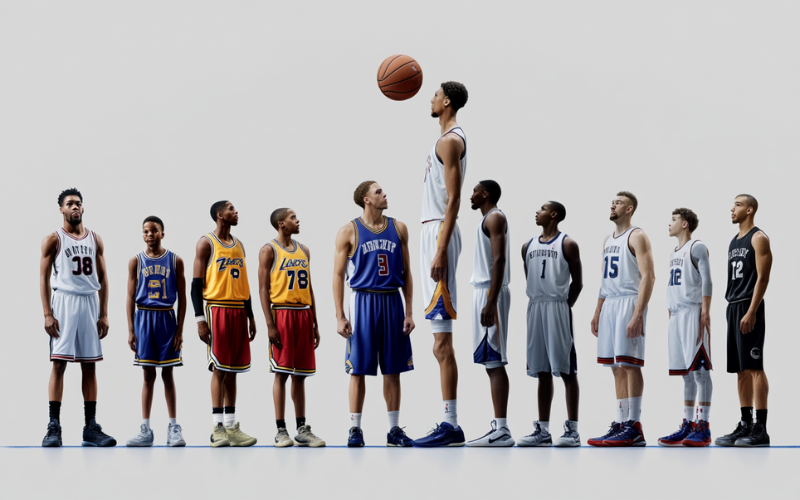The average NBA height is a topic of fascination for basketball fans and analysts alike. The physical stature of players not only impacts their playing style but also influences team dynamics and game strategies. In this article, we will delve deep into the importance of player height in the NBA, explore how it has evolved over the years, and discuss its implications both on and off the court.
An Analysis of the Typical Player Height in the NBA

In this section, we’ll break down what the average NBA height is today and give context to why it matters.
Historical Overview of Player Heights
The evolution of player heights in the NBA has been significant since its inception. Initially, players were relatively shorter compared to today’s standards.
The early years of the league saw players standing around six feet tall being considered giants. This changed as the sport progressed, with athletes realizing that height could provide a competitive advantage.
As the game became more athletic and fast-paced, taller players began to dominate the court. This shift led to teams reevaluating their recruitment strategies, focusing on height as a crucial attribute.
Contemporary Trends in Average Height
The current average NBA height hovers around 6 feet 7 inches, which is quite impressive. This increase from earlier decades reflects not just a change in athletic training techniques but also an advancement in nutrition and sports science.
Height plays a vital role in multiple aspects of basketball, including shot blocking, rebounding, and scoring efficiency. Taller players often have an advantage on the defensive end, making it harder for opponents to score.
However, this doesn’t mean that shorter players are at a complete disadvantage. Some of the most successful players in history have defied the trend and showcased exceptional skill despite not fitting the mold of a traditional tall player.
The Influence of Height on Playing Style
The influence of height extends beyond mere statistics; it significantly impacts how a player approaches the game. Taller players tend to excel in specific positions such as center or power forward, while those who are shorter usually thrive in guard roles.
Height can dictate a player’s ability to shoot over defenders or navigate through crowded paint areas. Moreover, a taller frame typically aids in shot-blocking and securing rebounds.
Understanding these dynamics helps teams tailor their strategies according to the strengths and weaknesses of their rosters. Coaches must harness their players’ unique abilities and design plays that capitalize on their height advantages.
The Correlation Between Height and Abilities in Basketball
While height may provide certain advantages in the game, it’s not the only determinant of success. Here, we’ll explore how skills, agility, and basketball IQ interplay with player height.
Competence Advancement Beyond Stature
When assessing a player’s potential, it’s crucial to consider skill development alongside height. While being tall can be beneficial, honing skills like shooting, ball-handling, and defensive footwork is equally essential.
Players like Allen Iverson and Chris Paul have shown that a lack of height can be overcome by extraordinary skill and basketball intelligence.
Moreover, with the increasing emphasis on positionless basketball, players are now expected to adapt to several roles regardless of their height. A tall player must develop guard-like skills, while shorter players need to learn how to play effectively in the post.
Agility: The Leveling Factor on the Court
Agility is another critical factor that can mitigate the advantages of height. Players with lower centers of gravity often exhibit superior balance and quickness, allowing them to maneuver through defenders and create opportunities.
This advantage can lead to explosive gameplay that challenges traditional notions of height in basketball. Teams are beginning to place greater importance on agility, leading to a balanced roster composition where both height and lateral quickness are valued.
Basketball Intelligence: The Transformative Factor
Basketball IQ refers to a player’s understanding of the game, including decision-making and anticipating opponents’ moves. This trait is independent of height and can often play a pivotal role in a player’s effectiveness on the court.
Players who possess high basketball IQ can read defenses, recognize offensive schemes, and make smart passes, proving that skill and intellect often outweigh physical advantages.
As a result, coaches are increasingly focused on nurturing players’ mental games, emphasizing teamwork, communication, and strategic thinking.
Impact of Height on Team Dynamics and Strategy

In this section, we’ll examine how the average NBA height affects team composition, strategies, and overall performance.
Strategic Modifications Informed by Player Stature
Coaches often adjust their strategies based on the average height of their team. A taller lineup might favor a more physical style of play, emphasizing post-ups and rebounds. Conversely, a shorter team may leverage speed and perimeter shooting.
For instance, teams with an average height of over 6 feet 8 inches often employ defensive sets that capitalize on their length, creating mismatches that can frustrate opposing offenses.
Additionally, teams may focus on exploiting the height differential by targeting specific matchups during games. This strategic flexibility becomes even more pronounced during playoffs when every possession counts.
The Influence of Elevation on Placement
Positioning on the court is deeply influenced by height. Centers and power forwards typically command the paint and are tasked with rebounding and shot-blocking responsibilities. Meanwhile, guards generally operate on the perimeter, facilitating plays and creating shots.
Teams with diverse height profiles can enjoy tactical versatility, allowing them to switch between different styles of play. For example, a taller team might experiment with a small-ball lineup to counteract opponents’ size advantages.
Achieving Equilibrium Between Stature and Proficiency in Team Composition.
Successful teams find a balance between height and skill when constructing their rosters. General managers assess player potentials not just based on their physical attributes but also their capabilities to execute game plans effectively.
This balance ensures that teams remain adaptable and competitive, capable of responding to various game scenarios. As the NBA evolves, teams that fail to prioritize both aspects risk falling behind in a rapidly changing landscape.
Height’s Cultural and Societal Impacts within the NBA
The conversation surrounding height in the NBA transcends the court and touches on broader cultural narratives. In this section, we will explore societal perceptions related to height and how they shape both players’ experiences and fan engagement.
Height and Its Social Implications
Height has long been associated with power, authority, and dominance across various cultures. These perceptions extend into sports, where taller athletes are often celebrated as “ideal” models for professional basketball.
For many fans, height represents an inherent advantage, feeding into the mythos of a “perfect” player. However, this overlooks the contributions of shorter athletes who have made significant impacts on the game.
Media Depiction and Stature
The media plays a crucial role in shaping public perceptions about height and basketball. Highlight reels often showcase towering players executing dunks, reinforcing the narrative that height equates to success.
Simultaneously, shorter players often face stereotypes that question their skills purely based on their stature. This duality highlights the need for more inclusive representations in sports media, showcasing talent regardless of height.
Motivating Future Generations
Inspirational stories of shorter players breaking barriers can motivate young athletes. Icons like Nate Robinson and Spud Webb have become symbols of resilience, demonstrating that determination can override physical limitations.
These narratives encourage aspiring players to pursue their dreams, regardless of societal expectations tied to height. Celebrating diverse heights within the sport can foster a more inclusive basketball culture that values talent above all else.
Conclusion
The average NBA height plays a profound role in shaping the dynamics of basketball, influencing everything from tactics to societal perceptions. As the game continues to evolve, so too will the narratives surrounding player heights, skill sets, and the endless possibilities of what it means to compete at the highest level.
From examining historical trends to understanding the implications of height on team dynamics, it’s clear that the conversation around height is nuanced and multi-faceted. As fans and analysts alike continue to explore these themes, one thing remains constant—the love for the game transcends physical dimensions, reminding us that talent, perseverance, and strategy ultimately define greatness on the hardwood.
